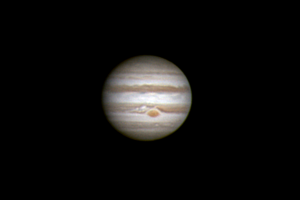I haven’t looked through a telescope in weeks. The second half of April seemed an endless string of cloudy nights and while I’m sure there were a few clear ones in there, one thing or another kept me from getting out under the stars with a telescope.
I am starting to miss observing and I can’t help but recall one of the last sessions of April, which happened to give the best views of Jupiter I’ve yet seen.
I was enjoying a pleasant evening out in the back yard with the kids when I first noticed Venus visible in the southwest and shortly after that was able to spot Jupiter, with some difficulty as the sky was still blue, near the zenith so I decided to bring out the 10″ Dob. Only a few weeks earlier I would’ve chosen a smaller scope but due to the mild weather that day I suspected the telescope would not need much, if any, cooling before being usable at high powers.
Starting with an 8-24mm zoom I was surprised at how steady the image appeared at 156x with the GRS and a shadow transit both readily visible. The boys each took turns looking and then my wife sat and watched, and tracked while I went inside to grab the binoviewers.
Using a binoviewer with a Newtonian can be tricky because the binoviewers introduce a longer light path than most Newts are designed to handle. A telescope like the AWB OneSky can be partially collapsed to allow a binoviewer to come to focus but a solid tube requires modifying the light path with a Barlow or Optical Correction System (OCS).
First I threaded the 2x OCS that works in my refractors into the binoviewer nosepiece, which was a no go in the Dob – still not enough in travel to reach focus – but I expected that. I have a 1.25x Siebert OCS that is designed for use with Newtonian reflectors and came to focus but the image with 26mm Plossls was small so that came off too.
I then threaded the element from a 2.25x Baader Q-barlow into the binoviewer nosepiece, which gives somewhere between 5-6x the magnification of the eyepieces being used so the power with the 26mm Plossls was around 300x. I was shocked by the view. The GRS and shadow stood out starkly. The division between the GRS and the SEB was enormous and white areas trailing the GRS were very clear and appeared like small ovals.

This photograph of Jupiter, taken by Ray Webster on April 16, 2015, shows many of the same features I observed on April 17.
I went to 20mm Plossls (over 350x!) and during glimpses of steady seeing the views were fantastic showing me details that I’ve previously only seen in photographs. This image posted by Ray Webster on the Cloudy Nights Solar System imaging forum from the night before comes pretty close to what I was seeing at the eyepieces. Thanks to Ray for allowing me to include his image here.
The binoviewers allowed viewing with both eyes, which is more comfortable and in my experience allows me to more readily recognize small detail, but the seeing was exceptionally good. More than once I’ve seen very good seeing around sunset and twilight get worse as night falls. Eventually the seeing did degrade and I first backed off the magnification, then packed it in completely.
But for about an hour we were treated to quite a show – a mass-produced Dob and basic binoviewers are capable of some pretty amazing planetary views when the seeing cooperates.
-Dave
Original content copyright 2015 by David Philips. All Rights Reserved. This post may contain links to affiliate sites; sales through affiliate links may benefit this site.